What your finger lengths can predict about you and others...
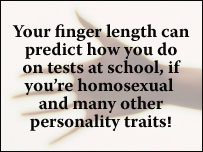
Fing lengths are different for men and women. But this difference can reveal a lot!
Here's how to know if he/she is lying to you...
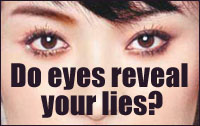
This article shows you how to "read" the eyes of your lover, boss or politician. It's the same tried and tested method used by Homeland Security, the police and FBI.
What does your handwriting tell about you?
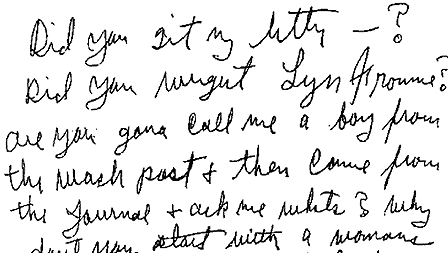
Learn everything about handwriting analysis in these free viewzone lesson by a professional!
All you ever wanted to know about fingerprints!
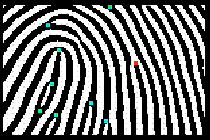
Each person's fingerprint is unique. Exactly how do they match them so quickly?
Take the Luscher Color Personality Test - It's FREE! Instant results.

What do your color preferences reveal about your hidden personality. See what advertisers and marketing professionals have known for decades.

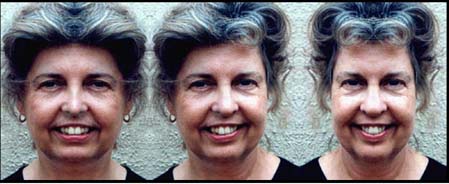
|
In the 1980s popular magazines introduced us to "cerebral specialization",
meaning the occurrence of distinctive cognitive styles in the right and
left hemispheres of the brain. While science has reached a few powerful
conclusions that help our understanding of cognitive processes like
intuition and creativity, popular enthusiasm for the new findings quickly
gerrymandered the new territory into politically correct districts.
The idea of people who effectively have two brains ("split brain" research subjects) processing sensory information independently appealed to the popular imagination just as the sensational story of Dr. Jeckyl and Mr. Hyde did a century earlier. "Jeckyl and Hyde" has entered our Jungian discourse as symbols of the functioning of the persona and of the shadow in each of us. Left brain and right brain people now populate our landscape, and it has become a political act to claim one of these complementary traits as one's persona, attributing the other trait to inferior others, thereby projecting one's own shadow onto them. We could almost say that the terms have reached the status of archetypes. The assignment of brained-ness to people required that cerebral dominance, which refers to the hemisphere that momentarily controls processing in the brain, became "cerebral dominance" denoting states of grace or despair. Anyone can now take cerebral dominance tests over the Internet. Left brain behavior has been extended beyond the linear thinking of lawyers and technicians to the entire tradition that originates in the Judeo-Christian, monotheistic culture. Right brain behavior appeals to artists and the new age community. But in declaring oneself right or left brained we mistake a process for a trait or quality, and commit a perilous act. Rather than try to squeeze ourselves into a category of "cerebral dominance" we might pursue the maintenance of, or even our ability to let psychic energy flow freely through the complementary cognitive specialties of both the right and left brains. Cerebral preference is a matter of degree stretching from inclination to addiction. A person unable to leave the confines of either brain's cognitive style is in a pathological state. Cerebral preference means the ability to use either imagination (right brain) or logic (left-brain) but with a preference for one or the other. Creative and Intuitive people are the ones who optimally use the appropriate cognitive style at each stage of these sophisticated processes. Intuition may tell us that an overly technological environment cries out for art or equally, that dreamers never prosper. Flow is a state of optimal health, but symmetry is not. Asymmetry suggests specialization and complementarity. While some readers have already studied charts of hemispheric specialization, here's a popular list for review:
Asymmetry seems to be the nature of our cerebral hemispheres, which apprehend sensory input, process images, and fire the synapses of the muscles that shape our face. Everyone knows that faces are not symmetrical, but I haven't found any research relating the lateral asymmetry of the mind to the asymmetry of the face. The face is a surface of skin covering 44 individual muscles that pull and push it into thousands of different expressions. Symmetry changes in the face as the most strongly felt emotions create maximum symmetry, whereas ambivalent states of mind are relatively asymmetrical. The relationship between expression and cognitive style can only be understood with the knowledge that the left brain both senses and directs the right side of the face, and vice versa. Consider the sets of triple images below.
  Each set of images began as a single negative. The second and third negatives were exposed ten and twenty seconds after the first. Each set of three images contains the original photo in the center with derived images on either side. The side images are not natural but contrived yet their perfect symmetry makes them appear strongly felt. If you were to cut a photograph in half through the vertical axis of the face and placed the cut edge against a mirror, a similar image would appear. The widths of the faces vary according to the degree to which the subject has turned her face to the right or left of the camera. The sequence of image sets demonstrates a shift of presentation from the right cheek to the left, with the middle set of images being more or less straight on. 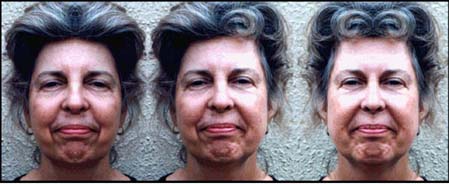  The right-side images isolate and emphasize the content and processes of the right brain (right brain controls left side of face, appearing on the right in our view), and the left side images have parallel significance. The realism of the original image disintegrates in the symmetrical side images to become something different that is simultaneously real and unreal. The dominant side of the face appears wider because the expressive person turns that side toward the viewer in order to emphasize her meaning. Taken together all nine images appear to be a series of masks of the personality. I see in these images instances of Carl Jung's descriptions of the shadow and persona. Perhaps the subject's dominant side represents her momentary persona, and that the side held back represents the shadow, lying behind the mask of the persona. The persona migrates in this sequence from the left brain to the right (the viewer's left to the viewer's right) with the shadow moving in the contrary direction. I took these photos of the subject and interviewed her as she moved through her performance, which was highly creative. I also assigned the cartoon labels as rough approximations for her expressions. The woman in the photos is highly creative and intuitive and she describes herself as left brained. As she prepares for the camera she obligingly presents the right side of her face and a pleasant, unassuming social smile to the camera. I chose the attribute "positive emotion" from the left brain list found above, and the cartoon labeled "good" to label the persona in the top left image. But the right brain is up to something on its own that becomes apparent only when we isolate and mirror its expression, creating the mask of the shadow as an entity in itself. I've associated her more animated and playful expression with the cartoon labeled "devilish. Ten seconds later the subject activates her right brain for inspiration. In the second set her "devilish" quest for inspiration results in an amused expression. The flow of energy between hemispheres has pulled her face toward symmetry so the lateral differences are subtler. The left side image (left brain expression) appears to me wisely agreeable to abdicating some of its reserve. The intensity of shadow and persona appear to diminish in soulful states of animated flow.
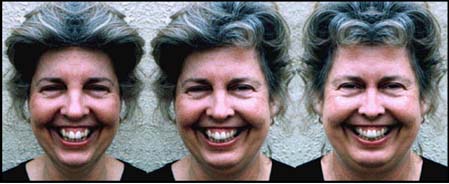  In the third photo she has shifted her head to the left as the right brain dominates her expression. of her mental state.. The subject reported that at the time she burst into laughter she was imagining the development of her idea. You can imagine ideas blossoming into intricate and colorful displays, becoming animated and sensational in the right brain. The left side of the face has come to express the persona, which appears giddy from pleasure, the happy but more sober left brain becoming the shadow aspect of her personality at this moment.
|
Viewzone Table of Contents || Comments? || --NEXT--
Other articles on the Left/Right brain phenomenon can be found at:
LEFT BRAIN:RIGHT BRAIN by Dan Eden
Rhythm Therapy -A new healing potential.